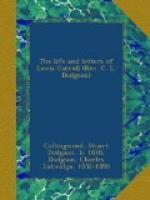Somewhere about this time he was invited to witness a rehearsal of a children’s play at a London theatre. As he sat in the wings, chatting to the manager, a little four-year-old girl, one of the performers, climbed up on his knee, and began talking to him. She was very anxious to be allowed to play the principal part (Mrs. Mite), which had been assigned to some other child. “I wish I might act Mrs. Mite,” she said; “I know all her part, and I’d get an encore for every word.”
During the year he published his book on “Determinants.” To those accustomed to regard mathematics as the driest of dry subjects, and mathematicians as necessarily devoid of humour, it seems scarcely credible that “An Elementary Treatise on Determinants,” and “Alice in Wonderland” were written by the same author, and it came quite as a revelation to the undergraduate who heard for the first time that Mr. Dodgson of Christ Church and Lewis Carroll were identical.
The book in question, admirable as it is in many ways, has not commanded a large sale. The nature of the subject would be against it, as most students whose aim is to get as good a place as possible in the class lists cannot afford the luxury of a separate work, and have to be content with the few chapters devoted to “Determinants” in works on Higher Algebra or the Theory of Equations, supplemented by references to Mr. Dodgson’s work which can be found in the College libraries.
The general acceptance of the book would be rather restricted by the employment of new words and symbols, which, as the author himself felt, “are always a most unwelcome addition to a science already burdened with an enormous vocabulary.” But the work itself is largely original, and its arrangement and style are, perhaps, as attractive as the nature of the subject will allow. Such a book as this has little interest for the general reader, yet, amongst the leisured few who are able to read mathematics for their own sake, the treatise has found warm admirers.
In the Summer Vacation of 1867 he went for a tour on the Continent, accompanied by Dr. Liddon, whom I have already mentioned as having been one of his most intimate friends at this time. During the whole of this tour Mr. Dodgson kept a diary, more with the idea that it would help him afterwards to remember what he had seen than with any notion of publication. However, in later years it did occur to him that others might be interested in his impressions and experiences, though he never actually took any steps towards putting them before the public. Perhaps he was wise, for a traveller’s diary always contains much information that can be obtained just as well from any guide-book. In the extracts which I reproduce here, I hope that I have not retained anything which comes under that category.
[Illustration: Dr. Liddon. From a photograph by Lewis Carroll.]




